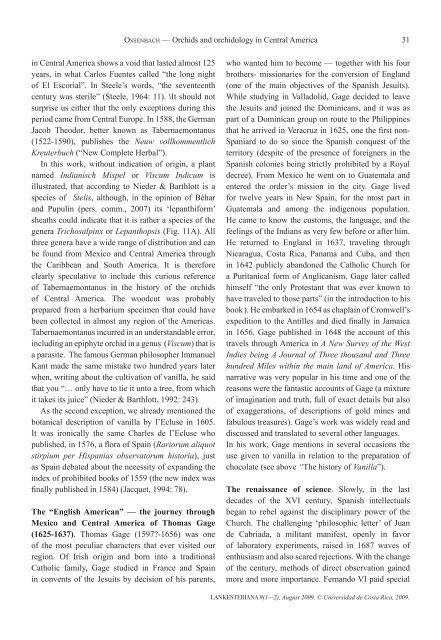orchids and orchidology in central america. 500 ... - lankesteriana.org
orchids and orchidology in central america. 500 ... - lankesteriana.org
orchids and orchidology in central america. 500 ... - lankesteriana.org
Create successful ePaper yourself
Turn your PDF publications into a flip-book with our unique Google optimized e-Paper software.
ossenbaCh — Orchids <strong>and</strong> <strong>orchidology</strong> <strong>in</strong> Central America<br />
<strong>in</strong> Central America shows a void that lasted almost 125<br />
years, <strong>in</strong> what Carlos Fuentes called “the long night<br />
of El Escorial”. In Steele’s words, “the seventeenth<br />
century was sterile” (Steele, 1964: 11). \It should not<br />
surprise us either that the only exceptions dur<strong>in</strong>g this<br />
period came from Central Europe. In 1588, the German<br />
Jacob Theodor, better known as Tabernaemontanus<br />
(1522-1590), publishes the Neuw vollkommentlich<br />
Kreuterbuch (“New Complete Herbal”).<br />
In this work, without <strong>in</strong>dication of orig<strong>in</strong>, a plant<br />
named Indianisch Mispel or Viscum Indicum is<br />
illustrated, that accord<strong>in</strong>g to Nieder & Barthlott is a<br />
species of Stelis, although, <strong>in</strong> the op<strong>in</strong>ion of Béhar<br />
<strong>and</strong> Pupul<strong>in</strong> (pers. comm., 2007) its ‘lepanthiform’<br />
sheaths could <strong>in</strong>dicate that it is rather a species of the<br />
genera Trichosalp<strong>in</strong>x or Lepanthopsis (Fig. 11A). All<br />
three genera have a wide range of distribution <strong>and</strong> can<br />
be found from Mexico <strong>and</strong> Central America through<br />
the Caribbean <strong>and</strong> South America. It is therefore<br />
clearly speculative to <strong>in</strong>clude this curious reference<br />
of Tabernaemontanus <strong>in</strong> the history of the <strong>orchids</strong><br />
of Central America. The woodcut was probably<br />
prepared from a herbarium specimen that could have<br />
been collected <strong>in</strong> almost any region of the Americas.<br />
Tabernaemontanus <strong>in</strong>curred <strong>in</strong> an underst<strong>and</strong>able error,<br />
<strong>in</strong>clud<strong>in</strong>g an epiphyte orchid <strong>in</strong> a genus (Viscum) that is<br />
a parasite. The famous German philosopher Immanuel<br />
Kant made the same mistake two hundred years later<br />
when, writ<strong>in</strong>g about the cultivation of vanilla, he said<br />
that you “… only have to tie it unto a tree, from which<br />
it takes its juice” (Nieder & Barthlott, 1992: 243).<br />
As the second exception, we already mentioned the<br />
botanical description of vanilla by l’Ecluse <strong>in</strong> 1605.<br />
It was ironically the same Charles de l’Ecluse who<br />
published, <strong>in</strong> 1576, a flora of Spa<strong>in</strong> (Rariorum aliquot<br />
stirpium per Hispanias observatorum historia), just<br />
as Spa<strong>in</strong> debated about the necessity of exp<strong>and</strong><strong>in</strong>g the<br />
<strong>in</strong>dex of prohibited books of 1559 (the new <strong>in</strong>dex was<br />
f<strong>in</strong>ally published <strong>in</strong> 1584) (Jacquet, 1994: 78).<br />
The “English American” — the journey through<br />
Mexico <strong>and</strong> Central America of Thomas Gage<br />
(1625-1637). Thomas Gage (1597?-1656) was one<br />
of the most peculiar characters that ever visited our<br />
region. Of Irish orig<strong>in</strong> <strong>and</strong> born <strong>in</strong>to a traditional<br />
Catholic family, Gage studied <strong>in</strong> France <strong>and</strong> Spa<strong>in</strong><br />
<strong>in</strong> convents of the Jesuits by decision of his parents,<br />
who wanted him to become — together with his four<br />
brothers- missionaries for the conversion of Engl<strong>and</strong><br />
(one of the ma<strong>in</strong> objectives of the Spanish Jesuits).<br />
While study<strong>in</strong>g <strong>in</strong> Valladolid, Gage decided to leave<br />
the Jesuits <strong>and</strong> jo<strong>in</strong>ed the Dom<strong>in</strong>icans, <strong>and</strong> it was as<br />
part of a Dom<strong>in</strong>ican group on route to the Philipp<strong>in</strong>es<br />
that he arrived <strong>in</strong> Veracruz <strong>in</strong> 1625, one the first non-<br />
Spaniard to do so s<strong>in</strong>ce the Spanish conquest of the<br />
territory (despite of the presence of foreigners <strong>in</strong> the<br />
Spanish colonies be<strong>in</strong>g strictly prohibited by a Royal<br />
decree). From Mexico he went on to Guatemala <strong>and</strong><br />
entered the order’s mission <strong>in</strong> the city. Gage lived<br />
for twelve years <strong>in</strong> New Spa<strong>in</strong>, for the most part <strong>in</strong><br />
Guatemala <strong>and</strong> among the <strong>in</strong>digenous population.<br />
He came to know the customs, the language, <strong>and</strong> the<br />
feel<strong>in</strong>gs of the Indians as very few before or after him.<br />
He returned to Engl<strong>and</strong> <strong>in</strong> 1637, travel<strong>in</strong>g through<br />
Nicaragua, Costa Rica, Panama <strong>and</strong> Cuba, <strong>and</strong> then<br />
<strong>in</strong> 1642 publicly ab<strong>and</strong>oned the Catholic Church for<br />
a Puritanical form of Anglicanism. Gage later called<br />
himself “the only Protestant that was ever known to<br />
have traveled to those parts” (<strong>in</strong> the <strong>in</strong>troduction to his<br />
book ). He embarked <strong>in</strong> 1654 as chapla<strong>in</strong> of Cromwell’s<br />
expedition to the Antilles <strong>and</strong> died f<strong>in</strong>ally <strong>in</strong> Jamaica<br />
<strong>in</strong> 1656. Gage published <strong>in</strong> 1648 the account of this<br />
travels through America <strong>in</strong> A New Survey of the West<br />
Indies be<strong>in</strong>g A Journal of Three thous<strong>and</strong> <strong>and</strong> Three<br />
hundred Miles with<strong>in</strong> the ma<strong>in</strong> l<strong>and</strong> of America. His<br />
narrative was very popular <strong>in</strong> his time <strong>and</strong> one of the<br />
reasons were the fantastic accounts of Gage (a mixture<br />
of imag<strong>in</strong>ation <strong>and</strong> truth, full of exact details but also<br />
of exaggerations, of descriptions of gold m<strong>in</strong>es <strong>and</strong><br />
fabulous treasures). Gage’s work was widely read <strong>and</strong><br />
discussed <strong>and</strong> translated to several other languages.<br />
In his work, Gage mentions <strong>in</strong> several occasions the<br />
use given to vanilla <strong>in</strong> relation to the preparation of<br />
chocolate (see above “The history of Vanilla”).<br />
The renaissance of science. Slowly, <strong>in</strong> the last<br />
decades of the XVI century, Spanish <strong>in</strong>tellectuals<br />
began to rebel aga<strong>in</strong>st the discipl<strong>in</strong>ary power of the<br />
Church. The challeng<strong>in</strong>g ‘philosophic letter’ of Juan<br />
de Cabriada, a militant manifest, openly <strong>in</strong> favor<br />
of laboratory experiments, raised <strong>in</strong> 1687 waves of<br />
enthusiasm <strong>and</strong> also scared rejections. With the change<br />
of the century, methods of direct observation ga<strong>in</strong>ed<br />
more <strong>and</strong> more importance. Fern<strong>and</strong>o VI paid special<br />
LANKESTERIANA 9(1—2), August 2009. © Universidad de Costa Rica, 2009.<br />
31
















